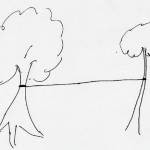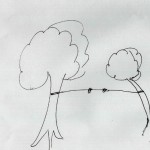Stretching—overstretching—can hurt your muscles. Last week I put pigeon pose on a pedestal. If you read the post closely, you will see that the yoga instructor did not introduce pigeon pose until 60 minutes of preparation. To go straight into pigeon pose would be like expecting your fingers to play the Moonlight Sonata after three weeks of piano lessons. Slowly, slowly after many lesser hip openers would you attempt pigeon pose.
This week, I bring back Julie Donnelly for some advice about stretching appropriately. She has a series of articles about preventing and healing repetitive strain injuries. Stretching can be a culprit. In this article there is a link to some materials she sells called Trigger Point Yoga. I have not tried these tools so can not recommend them from first hand experience. I have used a tennis ball placed between the floor and the knotted muscle and pressed down to release the knot. I’ve done this successfully for knotted places in the bottoms of my feet, my shoulders, and calves. I have used a broom handle and rolled along it with the outside of my thigh to release knotted T-band muscles. These techniques help. The key take-away is to avoid overstetching when the problem is a knot in the muscle. Read on….
Why do muscles cause pain? She calls this the Stretching Misconception.
STRETCHING SHOULDN’T HURT!
Have you ever felt so tight when you tried to move a joint that you decided to stretch? The odds are that you answered “yes” to that question. However, many people complain that they feel worse after stretching than they did before stretching.
Before getting into the specifics of the stretching misconception there are two words that need to be clarified. Many people confuse the word “spasm” with “cramp”. A cramp (also called a “Charlie horse”) normally involves all of the fibers of a muscle, and is when a muscle suddenly contracts totally. A spasm is like tying a knot in the center of the muscle and while it may only involve a few fibers; there can be multiple spasms throughout the muscle.
Each spasm feels like a bump when you slide your fingers deeply down the length of the muscle. These spasms normally form over an extended period of time, often from repetitive strain on the muscle fibers. Spasms are at the heart of the stretching misconception, so it is important that you think of a spasm as a knot in the muscle fibers in order to understand why it can hurt to stretch.
A muscle begins on a stationary bone, crosses over a joint, and then inserts into a moveable bone. When the muscle pulls on the moveable bone, the joint moves, however, if the muscle has a “knot” in it you can actually cause micro-tears to the fibers as you stretch.
HOW STRETCHING CAN HURT YOUR MUSCLES
Think of this analogy: visualize a strong tree with a rope tied to it.  The rope is the perfect length to attach to a flexible tree without bending the second tree. You can imagine if you pulled on the rope the flexible tree would bend over, and if you let go of the rope, the flexible tree would stand up straight again. This is a simple explanation of how a muscle pulls on a bone and causes the joint to move.
The rope is the perfect length to attach to a flexible tree without bending the second tree. You can imagine if you pulled on the rope the flexible tree would bend over, and if you let go of the rope, the flexible tree would stand up straight again. This is a simple explanation of how a muscle pulls on a bone and causes the joint to move.
However, if you tied a knot in the rope, the tree would bend. If you tied a second knot, the tree would bend even further.  If you then tried to stretch the rope so the flexible tree was standing straight, you would cause the knot to get tighter and the remaining rope would have to overstretch on both sides of the knot in order for the flexible tree to stand up straight.
If you then tried to stretch the rope so the flexible tree was standing straight, you would cause the knot to get tighter and the remaining rope would have to overstretch on both sides of the knot in order for the flexible tree to stand up straight.
This is exactly what is happening when you have a spasm, or multiple spasms, in your muscle. As you stretch you are causing the knot within the muscle to get tighter, and you are also causing the fibers on either side of the spasm to overstretch. This overstretching may cause the fibers to actually tear either along the length of the muscle, or where the fibers attach to the bone at either end of the muscle. This can be avoided by simply massaging the muscle to release the spasm before you stretch.
It’s now easy to understand why the repetitive movements that you do on a regular basis will cause the muscle to ultimately shorten into knots that we call spasms or trigger points. As I mentioned, when you try to stretch a spasm you can be causing yourself potential problems, and may even tear the muscle fibers.
Fortunately there is a solution. First you need to release the spasms that are causing the muscle to tie up into a knot, and then you can safely stretch. TriggerPointYoga was designed and developed to first eliminate the spasms in the muscle you will be stretching, and then continues to give four separate session of traditional yoga poses – two for the upper body and two for the lower body. You will gain flexibility and range-of-motion without injuring your muscle fibers.
Julie Donnelly is an internationally respected muscular therapist specializing in the treatment of chronic pain and sports injuries. She has co-authored several self-treatment books, including The 15 Minute Back Pain Solution,Treat Yourself to Pain-Free Living and Carpal Tunnel Syndrome-What You Don’t Know CAN Hurt You. Julie is also the co-developer of TriggerPoint Yoga. She teaches Julstro self-treatment workshops nationwide and is a frequent presenter at Conventions and Seminars. Julie may be contacted through her websites: http://www.julstro.com and http://www.TriggerPointYoga.com.
© Julie Donnelly 2013
Before you sign off, let us know if you have been successful identifying the difference between soreness in the muscles caused by knots or over use? And what did you do for the knots that helped?
Be Well, Do Well and Keep Moving,
Betsy
206 933 1889
For pain relief products by Shaklee go to www.HiHohealth.com